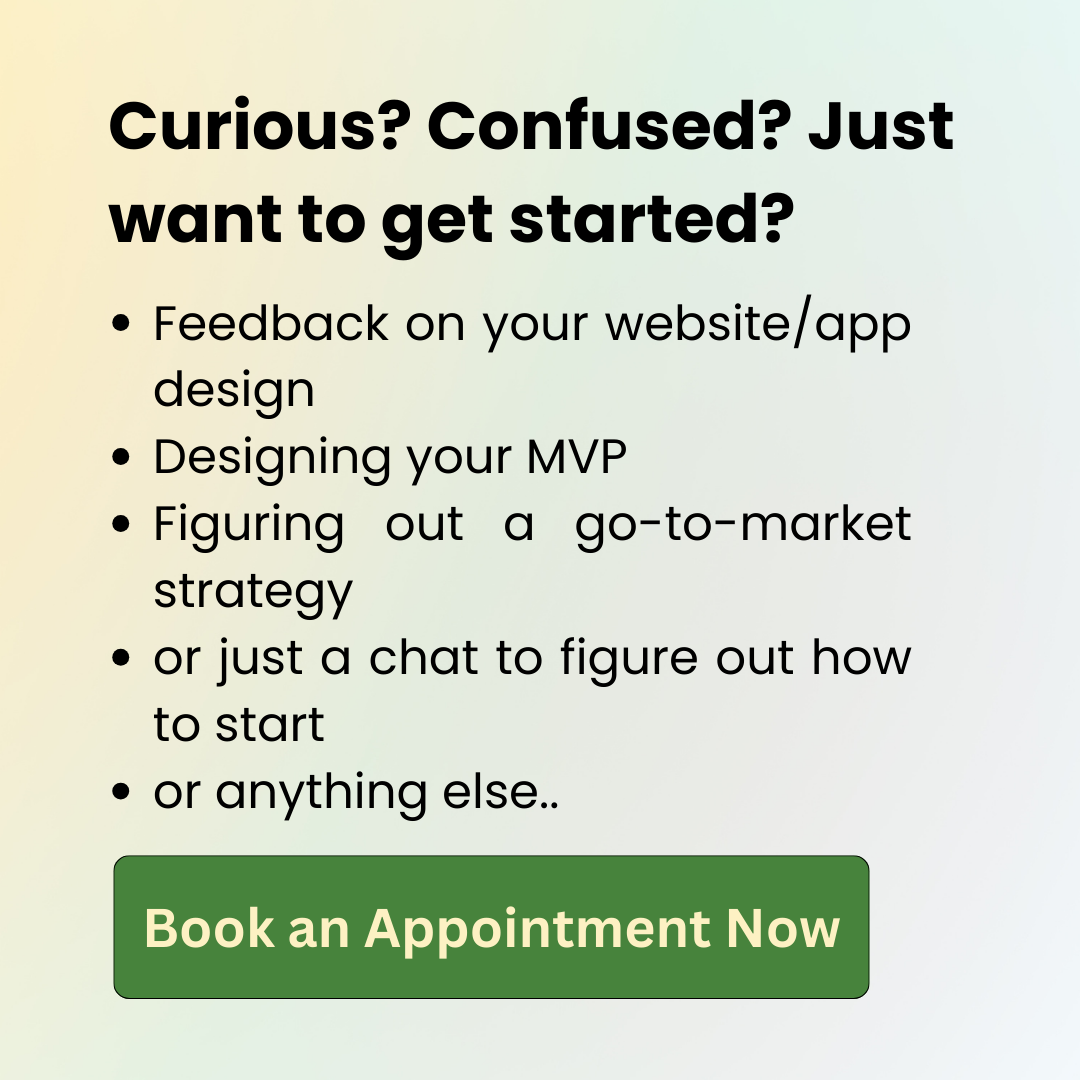“We think, We build, We launch”
Design Thinking
Design thinking is just another way of saying problem-solving. But as trivial as I have made it sound, it’s a lot more complex than that. Based on my experience and to help you understand it simply, there are three critical components to design thinking: the “problem,” the “solution,” and the “implementation.” Let’s delve into each of these in detail.

Table of Content
Understanding the Problem with Design Thinking
- For the purpose of this article, let’s assume you have identified a solvable problem, which marks the start of your design thinking process. Some may argue that problem identification is also a part of design thinking, but we’ll explore that another time.
- When it comes to problem-solving, we often find ourselves in the general area of the problem. Even if you believe you have found a problem worth solving, you are still in the general vicinity and haven’t pinpointed the exact problem yet. As I mentioned earlier, the problem is intertwined with the system, and unless you implement a solution, you will see that the problem, solution, and implementation keep evolving. Each component affects the others in a continuous cycle.
- Our understanding of the scenarios is limited until we implement the solutions. Real-world problems may differ greatly from what you initially sketched on the back of a napkin. They might even be systemic issues that arise unexpectedly during implementation. Anything can happen, and I can assure you that only about 10% of the plan goes as expected. The rest cannot be planned for, and you will need to solve problems as you progress.
- While we may hope for success, it is essential to convert hope into knowledge through thorough research. One common observation I have made with startup founders is that, instead of relying on comprehensive research, they rely on hope. While I do believe in learning along the way, many issues related to the solution can be resolved through research. Save your time by learning from the mistakes of others and conducting pragmatic research before diving into implementation mode.
By combining thorough research with hands-on problem-solving, you can leverage the power of design thinking to tackle complex challenges effectively.
Solution
The solution starts with the question “What if.” It wouldn’t surprise me if you actually began your design thinking process with a solution in mind and then researched whether it can solve a problem. Trust me, this happens all the time. It’s when you say, “I have an idea.” We rarely say, “I have a problem.” Typically, both the problem and solution emerge almost simultaneously.
Now, let’s examine your solution. In the case of a digital product, solutions manifest themselves as a set of features through which the solution is delivered. Consider the example of the age-old problem of hailing a cab. Uber came up with a solution: you can find a cab anytime through their app. You simply enter your location and destination, and a cab is available to you. This solution is delivered through a range of features. For instance, your location is automatically visible without the need to enter it manually. The system suggests addresses as you type. You can choose from a variety of available vehicles, and the fare is shown upfront, eliminating guesswork. Additionally, you can track the booked cab’s location and know exactly where the driver is, ensuring transparency.
All these features come together to provide a comprehensive solution. By implementing a set of features, you address multiple problems such as assurance of getting a cab, reduced waiting time, transparent pricing, and the convenience of booking a cab anytime. Throughout the process, you continue to implement features or combinations of features to determine what makes for a better solution.
Implementation
When it comes to implementation, you may encounter challenges that force you to reconsider the problem. You might discover that while the problem is worth solving, the solution would require significant time, money, or resources, which may not justify pursuing it.
The implementation process consists of three stages: design, test, and repeat. This is where many startups face difficulties. What to design first? How many users to test with? How to organise test results. Basically, how to define a hypothesis and then design and test it.
Some problems are deeply intertwined with sociocultural issues, regulations, innovation, technology, design, team dynamics, market climate, or funding availability. All these factors play a crucial role in the implementation phase. By iterating through these three steps multiple times, you will eventually uncover a problem statement that is truly worth pursuing.
Design Thinking – Part Two
The second part of this article delves into the question of what to build first: What feature set should your Minimum Viable Product (MVP) have? Now, here’s the interesting part. While some startups may secure funding at the idea stage, most of them need a working MVP to attract investors. Some investors may even prefer that the MVP generates revenue, although it doesn’t necessarily have to surpass the burn rate.
The Core Set of Features for Your MVP (Minimum Viable Product)
In my experience, I’ve come across many startups that I would describe as “over-coded,” “over-developed,” or “over-automated.” These startups tend to load their products with features that are nice to have but not necessarily needed when starting out with early-stage users who will validate your product. I have to admit, I was guilty of this too. When I was building a B2B2C e-commerce portal, coming from a design background, I felt that every feature was important. But the truth is, they weren’t.
At some point, you have to pause development and start testing your product with real users. But how do you decide when to launch and test? We all want to provide the best user experience, but we often forget that user experience also evolves over time. That being said, when building a B2C or D2C product, your UX (user experience) is the key differentiator, and you cannot compromise on that. However, it’s crucial to learn how to identify the product development phases and launch in a phased manner.
Identifying the Core Feature Set: Simplify and Prioritize
When building a product, it’s crucial to identify the core features that are essential for solving the original problem. These core features form the foundation of your minimum viable product (MVP). While it may seem challenging to determine these core features, once you do, it becomes much easier to build and test your product in a phased manner.

Let’s take the example of a food delivery app. The core feature set could include:
- Find a restaurant: Users should be able to search for nearby restaurants based on their location or preferences. This feature enables them to discover options available for food delivery.
- See the menu: Once users have selected a restaurant, they should be able to view the menu items and their corresponding details, such as prices, descriptions, and customization options. This feature helps users make informed choices.
- Create an order: Users should be able to select the desired items from the menu and add them to their order. They should also have the ability to customize their order based on their preferences, such as adding or removing toppings. This feature allows users to build their desired meal.
- Pay: Users should have a secure and convenient payment option to complete their order. This could include various payment methods like credit/debit cards, mobile wallets, or cash on delivery. This feature ensures a seamless checkout process.
- Get a confirmation: After placing an order and making the payment, users should receive a confirmation message or notification that their order has been successfully placed. This feature provides users with peace of mind and assures them that their order is being processed.
- Get the delivery: Finally, users should receive their ordered food at their specified delivery location within a reasonable timeframe. This feature ensures a smooth and timely delivery experience.
While these core features form the backbone of your food delivery app, there may be additional features that can enhance the overall user experience. For example, suggesting nearby restaurants based on the user’s preferences or featuring popular restaurants can be considered as add-ons. However, it’s important to prioritize these additional features and determine which ones make it to the MVP based on their impact on the user experience and the feasibility of implementation.

By identifying the core feature set and focusing on building these essential functionalities, you can create an MVP that addresses the key needs of your users while allowing room for further enhancements in subsequent iterations.
Get Your Hands Dirty: Prioritizing Your Feature Set
Let’s get practical and dive into an exercise in design thinking that can help you prioritize your feature set. You can use Trello, sticky notes, or even Google Sheets for this exercise. Create four columns or lists and divide your features into three categories. The names of the lists don’t matter; what matters is the division of features.
Here are the categories:
- All Possible Features
- Must-Have/Now
- Good to Have/Add-Ons
- Too Much/Future
Now, let’s create some labels to further refine our feature set:
- Value Proposition (VP): This label represents the value you’re creating for users and the reason they would use your product.
- Edge: If a feature gives you an edge over your competitors, label it as Edge.
- Value Undecided (VU): Use this label for ideas that may have potential value but require further exploration.
I am a strong believer in an entrepreneur’s instinct, so if you have thought of something, don’t exclude it from the list. At this moment you are not sure of its value but it may have some value.
Additionally, create another set of labels to gauge the usage and development time of each feature:
- Basic: A basic feature is mandatory to complete the core workflow, and all users are required to use it.
- Medium: This label indicates that approximately 50% of users will utilize this feature.
- Advanced: Use this label for features that only a few users can or will use.
Now, let’s consider the development time:
- Less/Low: Features labeled as Less or Low indicate that their development time is relatively short.
- More/High: Features labeled as More or High require more development time.
Steps to follow
- Now comes the fun part! Start labeling your features in the “All Possible Features” list with the appropriate criteria we defined. Don’t move the cards to the other lists just yet.
- Once you’ve finished labeling, you’ll notice that certain cards have combinations like Basic + VP + Low or Basic + Edge + High. Move these cards to the “Must-Have” list. Also, move the cards labeled as Basic + Other Labels + High to the “Must-Have” list.
- Next, move the cards labeled as Medium + Other Labels + Low to the “Good to Have” list, and move the rest to the “Too Much” list.
- Take a second look at the cards labeled as Basic + Other Labels and see if any can be moved to other lists based on further consideration.
What happens next will Surprise you!
This exercise in design thinking, when done as a team, sparks valuable conversations around the value proposition and adoption of your product. It provides everyone with a rationale for why certain features are being prioritized.
You’ll be amazed by the insights this exercise can bring. It sheds light on various aspects of your problem statement, solution, and implementation methods. If possible, record these discussions as they will be instrumental in shaping your business plan and investment deck.
Teams often come up with their own labels after the first round. Remember, these criteria are not universal, but they provide a process for filtering your core feature set. Your considerations for Basic, Medium, and Advanced features may differ.
Remember, this exercise also prompts you to delve into what your competitors are doing and how quickly you can gain an edge over them. They may have already solved part of the problem, so your focus should be on closing the gaps.
I'd love to hear your thoughts on this exercise. Feel free to share them here or email me at sunali@beonsystems.com. Let's continue the conversation!Photo by Polina Zimmerman: https://www.pexels.com/photo/notes-on-board-3782134/





